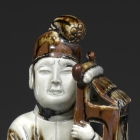J.J. Lally & Co., Oriental Art / New York City, New York
MenuPast Exhibition
Chinese Art: The Szekeres Collection
March 13-29, 2019
9.
THREE IRON-BROWN SPLASHED QINGBAI GLAZED
PORCELAIN FIGURES
Song Dynasty, 11th – 12th Century
a saddled and bridled horse with cropped mane and long tail, a standing groom with arms outstretched, and a standing attendant wearing a close-fitting headdress with lotus bud topknot carrying a small shrine with tiled roof over one shoulder, all made of high-fired white porcelain covered with a translucent glaze of very pale greenish tint liberally splashed with dark iron-brown.
Height of horse 8 3⁄8 inches (21.3 cm)
Height of figure with shrine 8 1⁄4 inches (21 cm)
Height of figure with raised arms 8 inches (20.5 cm)
Provenance J. J. Lally & Co., New York, 1987
Compare the Qingbai glazed porcelain group of a horse and two grooms illustrated in Kaogu, 1977, No. 2, pl. 12-3, excavated in 1970 from a Song dynasty tomb in the suburbs of Jingdezhen, dated by the Chinese archaeologists to about A.D. 1065.
A similar iron-brown splashed Qingbai porcelain figure excavated in 1970 in the suburbs of Jingdezhen, now in the Jiangxi Provincial Museum, is illustrated by Zhang (ed.), Zhongguo chutu ciqi quanji (Complete Collection of Ceramic Art Unearthed in China), Vol. 14, Jiangxi, Beijing, 2007, p. 44, no. 44, described as Northern Song dynasty.
Another Qingbai porcelain figure of closely related type is illustrated by Krahl, Chinese Ceramics from the Meiyintang Collection, Volume One, London, 1994, p. 335, no. 628, described as 13th century.
宋 青白醬彩俑三件
馬高 21.3 厘米 攜神龕俑高 21 厘米 牽馬俑高 20.5 厘米
